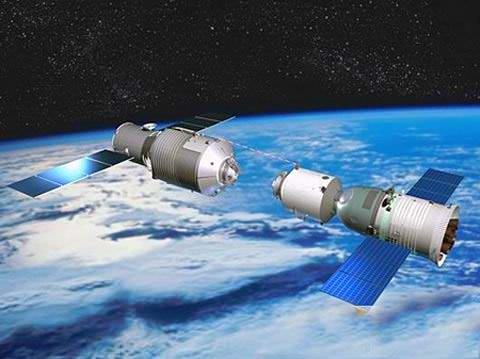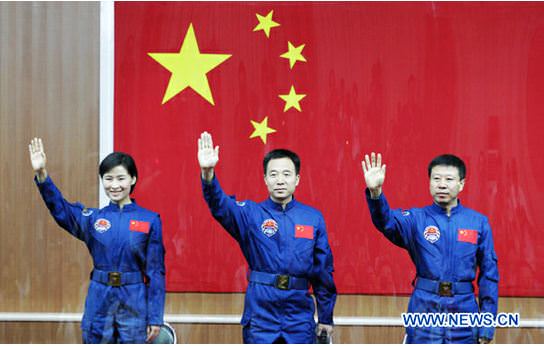China will launch a three-person crew on Saturday, June 16, 2012 at 10:37 UTC (6:37 a.m. EDT) on board a Shenzhou 9 spacecraft, heading to the Tiangong 1 spacelab. The crew includes Liu Yang, the first female Chinese taikonaut. With her will be Jing Haipeng, the commander and a veteran of two other spaceflights and Liu Wang. This will be the first manned docking to the Tiangong 1 (Heavenly Palace), which was launched in September 2011.
The Shenzhou 9 will launch from the Jiuquan Space Launch Center in the Gobi desert in western China.
Yang is a 33-year-old fighter pilot and said during a broadcast interview, “From day one I have been told I am no different from the male astronauts…I believe in persevering. If you persevere, success lies ahead of you.”
Liu joined the taikonaut training program in May 2010 and was selected as a possible candidate for the docking mission after she excelled in testing, according to the Xinhua news agency.
She initially trained as a cargo pilot and has been praised for her cool handling of an incident when her jet hit a flock of pigeons but she was still able to land the heavily damaged aircraft.
At a press conference, the three taikonauts were behind a glass wall before a small group of hand-picked journalists. They said the manual docking was a “huge test,” but that they had rehearsed the procedure more than 1,500 times.
“The three of us understand each other tacitly. One glance, one facial expression, one movement, we understand each other thoroughly,” said Jing.

Once Shenzhou 9 reaches the vicinity of Tiangong 1, the crew will perform a manual docking, but the Chinese space agency has said future missions will have automated dockings.
Some reports have indicated the Shenzhou spacecraft is designed with a common docking system that would allow it to dock with the International Space Station in the future should China be invited to visit.
Once on board the Taingong 1, the crew will do some medical research and conduct other research including monitoring live butterflies and butterfly eggs and pupae.
China has said they hope to add more modules to their space station, with a final version of it built by 2020. A white paper released last December outlining China’s ambitious space program said the country “will conduct studies on the preliminary plan for a human lunar landing.”
Lead image caption: China’s astronauts Jing Haipeng (C), Liu Wang (R) and Liu Yang meet with media in Jiuquan, China on June 15, 2012. The three astronauts will board Shenzhou-9 spacecraft on Saturday for China’s first manned space docking mission. Credit: Xinhua/Wang Jianmin
Second image caption: An artists rendering of the Tiangong-1 module, the first part of China’s space station. To the right is a Shenzhou spacecraft, preparing to dock with the module. Image Credit: CNSA
Sources: PeopleDaily, AFP, SpaceRef.


Interesting article, thanks! Is this sentence correct though? “China has said they hope to add more modules to their space station, with a final version of it built by 2010”
I saw that too and thought they might have meant that the modules themselves were completed in 2010?
That’s a typo. It will be 2020.
“From day one I have been told I am no different from the male astronauts”
She’s prettier, though.
Wow, is this woman Major Liu Yang talented. She was naturally selected because she is an member of the Chinese elite – the PLA (People’s Liberation Army.) It seems the military, as in the early American and Russian rocket launches again lies heavily with the armed forces before opening positions for scientists and engineers.
I do think her pride and nationalism is genuinely felt, and it is no wonder the publicity in China media has reach such fever pitch – openly already declaring her as a ‘heroine’. Her representation in their space program reflects quite well on Chinese woman and girls and their wider role in that society – no doubt boosting ideas of a more equitable and developing technical society. This is so different from Western society, who see it more as waving the feminist flag – as seen in some of the US and other western countries news reports. Chinese woman are clearly far more modest in their approach of the gender roles. No doubt this is why she said so emphatically correct that; “I believe in persevering. If you persevere, success lies ahead of you.” Is so hard not to agree.
Honest people can only wish her and the rest of the Shenzhou 9 crew a successful mission and a safe return to Earth when it is complete.
[It is such a pity that the powers that be in the United States did work so hard to make sure China was excluded from the ISS. No doubt this has been the driving force behind Chinese own space program. Let’s hope the US doesn’t begin to rue that past decision with continuing successes here.]
I bet that in a few years from now these Chinese will catch us by surprise and land on the Moon.
You will lose the bet. Where will they get the rocket designs to copy from ? The Russians never sent a man anywhere near the moon.
The rockets and capsules they now use are also no copies. And they built these things in big secrecy. They will not warn the world that they will head to the moon, then will just do it to show off the power they have.
If you are really adamant that China copy all designs, that is no problem since the russians had derived the hardware for a manned moon visit and launched several moon rockets for the mission (but failed).
But they have stated that they will develop the hardware and get the experience if needed, and we have no reason to believe they are unable to do so.
Besides that they haven’t copied much from russians specifically besides some basic architecture. That is mostly the easily started and weather resistant hypergolics in the launchers, and the maximize-living-space-by-minimizing-return-mass concept. Apollo was intended for hypervelocity returns and the Shuttle for reuse so couldn’t do the latter, and were all started from near equator bases so didn’t need the former.
Instead they have nicked some asian/european launch concepts, clusters of strapon boosters, and probably an international docking hatch design. They have added some ideas of their own, since the service module can do independent and longtime missions, maximizing ROI.
Looking at it from a commercial space angle they have gone about it as a startup would do in a settled industry with little innovation, at least at the entry level. They have emulated tried and true designs while getting their feet off the ground so to speak. In that respect they have done nothing that SpaceX haven’t done, except for adopting car industry lean mass production methods ironically initiated by the US (Ford) but not suitable for once-in-a-while national missions.
Great! And they choose to include women early on instead of exclusion, even better. The keeping cool requirement is probably still important, they need some more missions and tests of hardware before it is deemed safer.
Which is why I give extra wishes for their mission’s success!
where can we watch the launch live on the web?
Wish them success in their mission!
She’s good looking 🙂